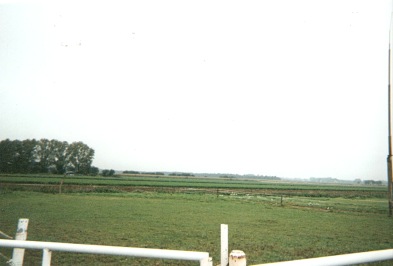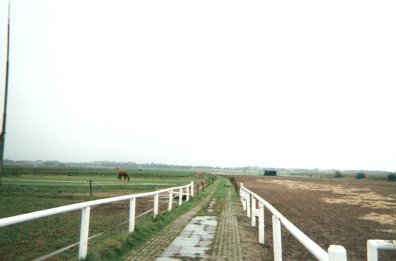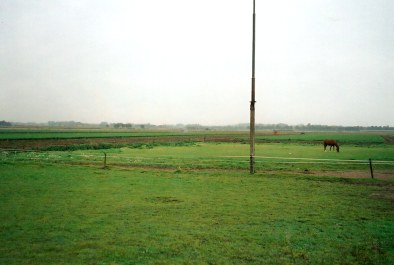
Home
TOC
Contact
Links
Credits
Maps
Forum
Video
Joe Crilley
|

The Dike |
|
 |
Pictured below is a photo from the Bed and Breakfast we stayed at. The tree line on the left, an old dike, is where the 327th/401st Glider Infantry Regiment dug in to form a secondary line of defense just east of Opheusden. After two days of battle, the first battalion of the 506th PIR, which replaced the third battalion in that area, was forced to withdraw with 120 seriously wounded men. The battalion pulled back over a mile to a apple orchard, directly behind me where a power station exists today, to regroup, reorganize and reequip themselves.  To cover this withdraw, a small unit of American paratroopers were left behind to hold off any German attack on this retreating army. One of the soldiers was 19-year old Donald Burgett, who would later write four books about his experiences during World War II. This unit would withdraw along a different route that the others had taken, they would swing south first and then move to the apple orhard. As they approached the area in the early foggy morning, they noticed a large group of soldiers who were not 101st men because they didn't have the many large pockets so predominate with the Screaming Eagles. "Don't worry they are English" said Lt. Borreali and they continued to walk to the north section of the orchard as they exchanged waves. Burgett joined his unit and dug in for some rest. In the middle of the orchard was a hand operated water pump and a stack of hay. English soldiers and Americans both alike traveled to the center to fill their canteens with water and get some straw for their foxholes, but never at the same time. To cover this withdraw, a small unit of American paratroopers were left behind to hold off any German attack on this retreating army. One of the soldiers was 19-year old Donald Burgett, who would later write four books about his experiences during World War II. This unit would withdraw along a different route that the others had taken, they would swing south first and then move to the apple orhard. As they approached the area in the early foggy morning, they noticed a large group of soldiers who were not 101st men because they didn't have the many large pockets so predominate with the Screaming Eagles. "Don't worry they are English" said Lt. Borreali and they continued to walk to the north section of the orchard as they exchanged waves. Burgett joined his unit and dug in for some rest. In the middle of the orchard was a hand operated water pump and a stack of hay. English soldiers and Americans both alike traveled to the center to fill their canteens with water and get some straw for their foxholes, but never at the same time. As it got lighter an American soldier is looking south and suddenly shouts "they're Krauts!", the nickname the Americans gave to the Germans. In a confused and wild fightfire the 101st defeated the German 958th Regiment of the 363rd Volks-grenadier Division that had advanced along the railroad lines and then got lost, stopping to try and find exactly where they were. Where they were is where the Americans had set up their encampment. After the battle was over and 155 Germans were prisoners, Pvt. Burgett approached the Germans and asked them if they had seen him walk up the road not so long ago. Someone replied that they saw the men come up the road and the)' could see that they were 101st paratroopers but believed they were prisoners. Apparently one of the men in the rearguard was caring his .30 caliber machine gun across the back of his neck with his arms upward which the Germans mistook as a surrendering soldier in the darkness. As it got lighter an American soldier is looking south and suddenly shouts "they're Krauts!", the nickname the Americans gave to the Germans. In a confused and wild fightfire the 101st defeated the German 958th Regiment of the 363rd Volks-grenadier Division that had advanced along the railroad lines and then got lost, stopping to try and find exactly where they were. Where they were is where the Americans had set up their encampment. After the battle was over and 155 Germans were prisoners, Pvt. Burgett approached the Germans and asked them if they had seen him walk up the road not so long ago. Someone replied that they saw the men come up the road and the)' could see that they were 101st paratroopers but believed they were prisoners. Apparently one of the men in the rearguard was caring his .30 caliber machine gun across the back of his neck with his arms upward which the Germans mistook as a surrendering soldier in the darkness. The battle was actually a trap that the 10tst had set up. They used their retreat to draw the Krauts into their lines where the Airborne artillery could get them in the open. The Germans didn't follow the plans so well as they got lost and stopped in the orchard to find out where they were. This happened on October 7, 1944. The battle was actually a trap that the 10tst had set up. They used their retreat to draw the Krauts into their lines where the Airborne artillery could get them in the open. The Germans didn't follow the plans so well as they got lost and stopped in the orchard to find out where they were. This happened on October 7, 1944.
|
|





